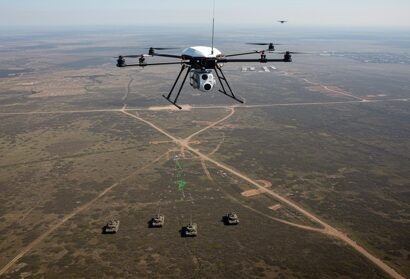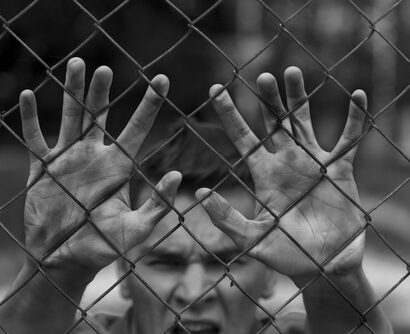Abstract: The military domain provides rich literature and technology on war and underlines the importance of technology in helping militaries win wars. Academics have sought to analyze the connection between human capital and technology and how those two depend on each other. Moreover, history shows that a great leader was always followed by its troops not only because of his proven qualities but also for his way of leading. Nowadays, leaders face a variety of challenges. First, they have to understand and manage the contemporary operational environment characterized by volatility, uncertainty, complexity, and ambiguity (VUCA). Secondly, they should accept that technology is a key driver of change and integrate it in a positive manner in the troop’s activities. Moreover, leaders should manage the transition between the old and the new generation of human resources within military organizations.
Problem statement: How to understand contemporary challenges’ impact on modern military leadership?
Bottom-line-up-front: In addressing the aforementioned issues, this article explores the challenges of the VUCA environment and the impact of technology on Generation Z to identify organizational methods or managerial instruments to recruit, educate and shape the new generation of military leaders.
So what?: Leading troops or managing personnel represent mandatory conditions for the Military organization. Without a tailored leading approach, all the organizational objectives will experience difficulties in achieving them. It is time for academics and practitioners to work together and find suitable approaches for leading the military structures.

Source: shutterstock.com/Andrew Angelov
VUCA and Generation Z
A lot of literature has discussed leadership within different organizations. There are various arguments to support this interest in leading: efficiency depends on leaders, personnel retention, and management of resources. Besides leadership, the need to describe a new state of environment brought up a concept known as “VUCA” (Volatility, Uncertainty, Complexity, and Ambiguity). Nowadays, Volatility, Uncertainty, Complexity, and Ambiguity are constant lenses used in different approaches, such as in economics, society, and in the military. Also, updated changes influenced by technology development made Generation Z a highly addressed topic. This article investigates the requirements of leadership in the Romanian military organization. The research focuses on two significant variables that significantly impact the military: the new human resource represented by Generation Z and the VUCA environment’s influences.
Volatility, Uncertainty, Complexity, and Ambiguity are constant lenses used in different approaches, such as in economics, society, and in the military.
The process of adapting leadership within the military organization addresses all inner components. Not only finance, logistics, or planning but also human resources, Civil-Military Cooperation (CIMIC), and communication should be involved in finding capable solutions. Some departments have indeed limited responsibilities in meeting the requirements, while others are deeply involved. However, one may focus on the Human Resources (HR) component because it plays a significant role in leadership development. Regarding leadership, the HR department has responsibilities such as:
– Identifying the key leader positions;
– Drawing the necessary competence for leaders;
– Establishing the subordinated structures and their responsibilities;
– Giving the career path guidance; and
– Establishing the required studies for a leader in accordance with the level of responsibilities.
Military HR is responsible for sharing common regulations in the military field. The general framework focus on guiding military behaviour is another HR’s attribute. On the one hand, HR gives guidance to the education department. On the other hand, it is directly responsible for the professional path of military personnel. HR provides not only requirements for different positions but also guidance regarding the necessary studies or professional experience.
Therefore, the HR component is in a significant position of responsibility to balance the military organization’s requirements and human resources potential.
A Volatile Strategic Environment
Romania has been a NATO member since 2014, and nowadays, it has a great responsibility to provide stability at the eastern borders of the alliance. Moreover, the ongoing war between Russian Federation and Ukraine and the crises caused by the pandemic significantly influences the military organizational environment. In addition, the numerous global conflicts and the decreasing resources endorse the Volatility, Uncertainty, Complexity, and Ambiguity (VUCA) within the military organization. In addition, the military conflicts happening in different regions of the world, the transformations caused by climate changes, and the great powers’ intention to expand their influence on others contribute to the decline of resources. Not only the unreasonable consumption of resources but the inadequate behavior with respect to nature also greatly impacted the amount of resources. This presents a need for empirical research to find the direction for future military leadership.
The military conflicts happening in different regions of the world, the transformations caused by climate changes, and the great powers’ intention to expand their influence on others contribute to the decline of resources.
The VUCA Environment – A Different Framework for Military Personnel and Leaders
The VUCA[1] environment can be understood from a large variety of perspectives. The approach we want to share is focused on the influences of VUCA on the military organization routine and its components. The military organization is legitimized as a hierarchy, and the entire activity is based on a consistent chain of command. Moreover, research showed that the hierarchy is an appreciated organizational value, and the employees considered it required for the military organization of tomorrow.[2] It is not only a requirement according to International Law but also a prerequisite to be recognized as military. With respect to this, what should the organization do to provide leaders defined by proactive behaviour capable of running contemporary troops?
VUCA is an acronym used, amongst other fields, in all organizational sectors characterized by changes.[3] Understanding the VUCA of the military organization is mandatory because every member can be affected by the measures taken to re-establish the balance. Regarding the meaning of VUCA, a sum of requirements for military organizations and HR components have to be identified. Generally speaking, volatility refers to unpredictable and frequent changes on a large scale[4], and the features of volatility represent demands for the military organization:
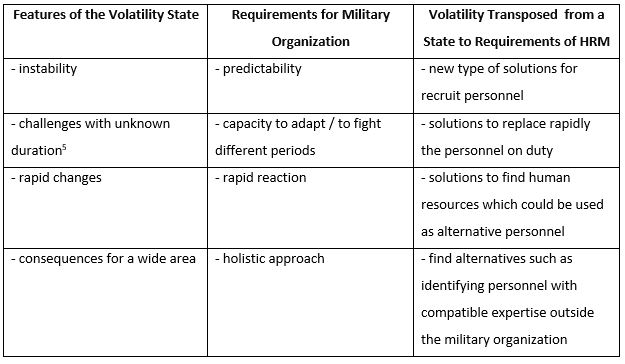
Source: author
This state brings a limited capacity for prediction regarding the number of personnel. There will be unpredictable situations described by the unknown duration that will need personnel. For example, a military conflict could require just a division or could ask for an entire Army. On the other hand, the expertise of the required personnel will be another issue. Using specialists from outside the military could be an alternative solution.
Uncertainty is related to the limitedness of information. The presence of technology in our daily routine and the fact that we can establish connections and communicate easier increase the exchange of information. The flows are considerable, and the shared content has another meaning. A piece of information shared between soldiers using different means can be understood or used in various ways. Some of the soldiers can be submissive to authority, but others may not. This enormous amount of information also brings self-doubt and uncertainty to military personnel.
The presence of technology in our daily routine and the fact that we can establish connections and communicate easier increase the exchange of information.
In the past, we had limited resources and needed considerable time to become well-informed. Nowadays, information represents not only power, knowledge, and influence but also threats, manipulation, uncertainty, and insecurity. The military organization is not prepared to manage all the contemporary information, anticipate what will happen in the immediate future, and find a suitable way to act or respond. Their capabilities were designed (in all the domains: human resources, technical, etc.) to match requirements connected with the past military organizational environment. In this new context regarding the uncertainty, we identify a sum of demands for the military organization and HR component:
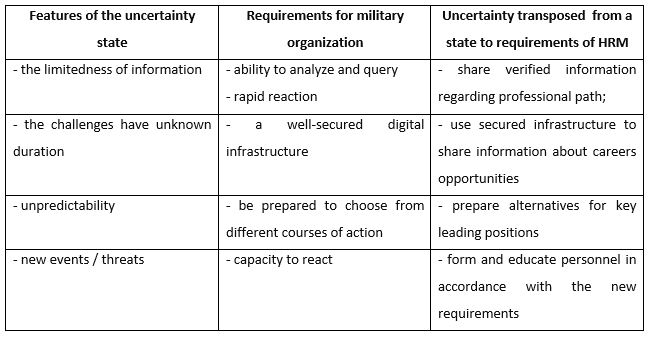
Source: author
This state represents a real challenge for leaders because they cannot use past events in the decision-making process. In this context, the military organization has to help leaders by providing them with the necessary support. On the one hand, it must find the mechanisms to properly manage all the information flows. Moreover, it has to protect its militaries from misinformation by analizing and filtering the sources. On the other hand, a well-secured internal communication infrastructure for sharing essential information about personnel is vital for a healthy HR system.
The military organization has to help leaders by providing them with the necessary support. It must find the mechanisms to properly manage all the information flows. Moreover, it has to protect its militaries from misinformation by analizing and filtering the sources.
Complexity is connected with the multiple causes and factors involved in a problem. The organizational environment of the military we knew before had limited types of threats. For example, the armed conflict has been transforming a lot in the recent past because of information technology.[6] More and more unpredictable events and new threats appear. In the past, not only the soldier but also his leader knew which were the threats and the required procedures. Nowadays, the environment has become a real puzzle with multiple unknown pieces. The amount of information, the increasing requirements, and the lack of established procedures or solutions bring about confusion and indecision. Even if the means of communication, artificial intelligence, or databases already have a meaning in the military, the pressure of the VUCA environment is being felt not only by the leaders but also by the soldiers. In addition, the new type of human resources, which is characterized by a different spectrum of features than the previous one, also represents a challenge for the military. At the same time, the career path became difficult to predict. Nowadays, an officer does not know what to do to become capable of leading the troops. Leaders today are confused about which competencies are required of them. In addition, the new type of human resources characterized by a different spectrum of features than the previous represents a challenge for the military.
In the past, a leader could review previous organizational experiences and identify solutions for his challenges by comparing his problem with an old identified one. Nowadays, the reality is different. In addressing a solution, man has to take into account a large spectrum of information and be ready to immediately change his decision because of the potential of the change that has just occurred.
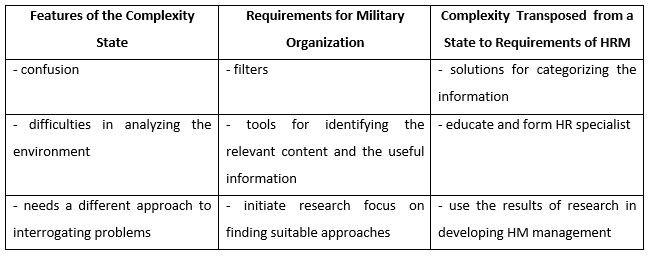
Source: author
In this context, HR should find solutions based on the research. The HR component has to consider specializing personnel to support the soldiers throughout their careers, giving the right direction brings suitable competencies and produces leaders.
Ambiguity is defined as the lack of clarity about the meaning of an event.[7] To develop a course of action, it is imperative to know who, what, where, how, and why. The decision-making process also regards all that information and brings multiple decision points. Knowing just a part of the answers will significantly affect the end state and the entire process. Moreover, the decision-making process can be paralyzed because of the lack of certain information, and future plans, projects, or objectives could be jeopardized.
The decision-making process also regards all that information and brings multiple decision points. Knowing just a part of the answers will significantly affect the end state and the entire process.
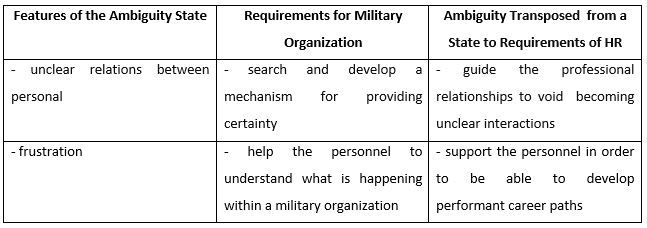
Source: author
In addition, technology has a special meaning in a VUCA military organizational environment. Daily professional routine depends on the devices, and the amount of information cannot be managed without them. Technology can be considered not only a positive asset but also a challenging one. The potential disruptions in technological dependency can prove disastrous in light of new trends.
According to this analysis, we draw a few conclusions:
- Because of VUCA influences, the military organization must implement multiple changes. Moreover, the initiatives may be needed in various areas, and different domains may also be covered. In this idea, a leader should have knowledge and competencies in multiple domains. Therefore, the leader should be the architect of change. Leaders must know how to motivate human resources to determine proactive behaviours.
- The environment is a giant consumer, and the resources are decreasing. Not only the logistical resources are hardly accessible, but also the available time is limited. The military leader should take into account not only the general framework but also the details of the problems. Defence resource management should also have an integrated approach.
- Military personnel is used to working with standing procedures, but the features of the new environment require changing past experience.
- The ongoing changes affect all the members of the organization, and the leader should know how to give support where needed.
- The limitedness of information imposes great analytical and synthetic restrictions over military capacities. Leaders should know how to guide their subordinates and help them to identify relevant information.
- Leaders should focus on enabling teams to deal sustainably with the changes. They are not able to do anything by themselves.
- The VUCA asks for action: change should be seen as a continuous planning process. The military organization has to find what is needed, choose a course of action, observe the effects, identify what is working and implement it.
What we know for sure about the VUCA effect within a military organization is that change will happen steadily. The military organization will have to find mechanisms to compensate for these changes. We know that the military has a strong chain of command. We also know that the organizational culture is persistent and solid. Moreover, technology is a constant presence. With respect to these, the military must find tools to balance the military organizational environment.
The Transition Between Generations
Karl Mannheim, a Hungarian sociologist, was the first to highlight the importance of the generations. He defined the generation as a group of people connected in time and space. The members behave similarly and give a common significant to the experience they had.[8] The main reason we are interested in generations is thateach of them has specific features. Generations are clearly identifiable from different values, particularly learning styles, and effective leadership principal to behave and approach professional responsibilities. The military organization has many reasons to be interested in the new generation. As literature has shown, both society and researchers are giving a lot of attention to Generation Z. It is significantly different from their predecessors.[9] To find out the differences between the last two generations, we will compare Generation Z with the Millennials. This resemblance is significant for our research: it will provide helpful ideas to build managerial solutions.
Generations are clearly identifiable from different values, particularly learning styles, and effective leadership principal to behave and approach professional responsibilities. The military organization has many reasons to be interested in the new generation.
The aforementioned characteristics were found using two methods. First of all, we did analytical research using a sum of articles about both generations. Secondly, direct observation led to a sum of features. The identified features highlighted that there are significant differences between generations. Each of them has both positive and negative aspects.
Analyzing the features, one may consider that there is a sum of weaknesses of Generation Z that should be carefully managed. This new human resource has a short attention span, needs a lot of explanations, and prefers to be appreciated for their individual work.
On the other side, members of Generation Z are digital natives and considered innovative thinkers. One can say that they are prepared for the next technological level. They will proficiently operate the technology on the horizon, including augmented reality headsets, drones, and autonomous cars. Moreover, this generation grew up in a world dominated by uncertainty, and was already initiated into behaving in accordance with the new requirements. This generation seems to be more intellectually prepared for danger and uncertainty.
Needs, Requirements, and Perspectives
Even if Generation Z has already joined the military and has a different position, including leading spots at the tactical level, it is premature to conclude the way they have adapted themselves to it. Moreover, it is time for Military organization to define new development directions. It has to set up the field for the new generation of human resources.
The Military should clearly create a mechanism orientated to absorb the differences between generations. Moreover, the potential of ”digital natives” should be capitalized properly. It has to be taken into account that we will have a mixture of generations in the military for the next years. The contemporary leaders are members of the Millennials, and the junior Military employees were born after 1996. The transition should be done smoothly and based on the old organizational cultural values.
The potential of ”digital natives” should be capitalized properly. It has to be taken into account that we will have a mixture of generations in the military for the next years.
There is a shifting demographic within the military towards the newest generation of the armed forces. In this context, a military organization should adapt and meet the hurdles posed by this demographic shift. The end state for the military is to understand the requirements of the new human resources and use them as an advantage to ensure the organisational missions.
The punitive leadership style is no longer effective. Members of Generation Z need explanations and guidance, not only simple commands.[10] At the same time, it is difficult to change the behaviour of a mature leader and reconstruct his values and principles.
The new generation views leadership horizontally as opposed to the traditional vertical hierarchy the military has. This can be both a blessing and a curse for them, as the fact that they can accept command from people of the same rank will make them better subordinates and leaders. They will be able to accept counseling and advice from people who are not their direct commanders, thus taking more objective decisions and exercising a better command act across their troops. On the other hand, they could have difficulty accepting the commands without getting explanations. Nevertheless, we must consider that there are moments when time is not friendly, and decisions should be taken fast.
Another contributing factor to future commanders’ education will be their tendency to prefer working alone, which contradicts the principle of esprit de corps. However, they may compensate for this with their multi-tasking abilities. The military organization is, more or less, a Janus with two faces: in times of war, authentic leadership is an indispensable requirement to achieve success, while in peace, the officers occupy their time with more administration and bureaucracy, especially as military units have reduced active personnel, sometimes lower than 50% operational employment which means that the same officer may hold several attributes at the same time.
All in all, we draw a few conclusions based on the results of this research. We consider these ideas’ start points for future changes:
- Communicating values and cultural, organizational expressions as a springboard to the future. When joining the military, most recruits will have limited knowledge about the organization.
Adapting is not just about changing the system; it is also about building on top of a solid foundation. The cultural organization is a critical foundation and can be used to grow new generations of leaders.
- Sustain a solid social contract between the military and the military.Nowadays, military personnel decides to quit the armed forces for civilian life, which is often better paid and well appreciated. As we remarked, Z Generation would not be loyal if the organization did not help them feel valued for their actions.
- Create and implement mentoring programs to support military personnel. The functions of mentoring can be approached from a different point of view. For example, role-model could help provide desired leadership behavior. Moreover, using e-mentoring can be attractive to Z Generation. The mentoring function of supporting the career helps inform the personnel correctly and reinforces the social contract between the military and its soldiers.
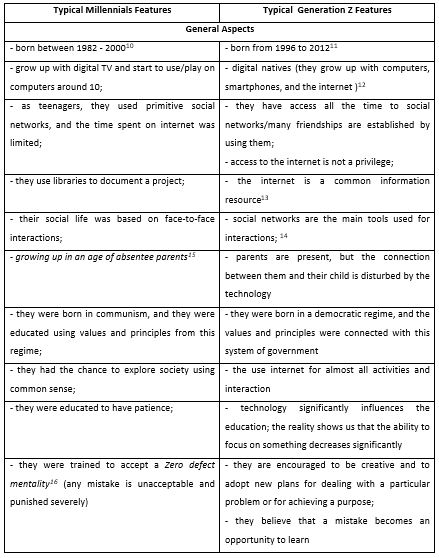
Source: author

Source: author
Conclusions
A military organization needs to manage its environment to provide secure conditions for the transition between generations. Generation Z puts pressure on the military organization because of their distinguishing features: ”digital native”, short span of attention, consumers, individual work orientation, low level of hierarchy acceptance, and others. On the other hand, the contemporary organizational environment has become unsecured and packed with many threats. Adapting to modern technology and its permanent presence within daily work represents another challenge for the military organization and its personnel. With respect to these, a military organization needs to focus on all that changes and start to develop future plans.
First of all, being a very conservative organization regarding its practices and traditions, the military will need to make significant efforts to attract and keep its new members. Perhaps the most important resource of the organization, the human capital is a factor we cannot neglect in forming the Z Generation personnel as their own rights, a big undertaking taking into consideration the contemporary financial, industrial, and security situations we live in today. Secondly, the organization should take into account developing a culture of mentorship in order to communicate values and principles. In this manner, the gaps between generations could decrease, and the military nucleus’ cohesion will be stronger. Furthermore, the social contract between the military and its employees should be based on values such as trust, loyalty, and devotion. In the final, the leader should be educated to become the promoter of all the changes, and the military organization has to focus on his/her education and formation.
Perhaps the most important resource of the organization, the human capital is a factor we cannot neglect in forming the Z Generation personnel as their own rights, a big undertaking taking into consideration the contemporary financial, industrial, and security situations we live in today.
This article has a limitation: one of the methods used to collect data (direct observation) was limited to the Romanian Military organization. This aspect directly influenced the military’s behaviors through (at least) national context (communism regime, education, values).
Gabriela-Florina Nicoara; Major, Senior instructor, PhD candidate, Command and Staff Faculty, “Carol I” National Defense University; Research interests: defense resources, management, human capital, leadership, logistics; Earlier publication:Considerations Regarding the Integrated Approach to Defense Resources Management – article published in Romanian Military Thinking no.1/2022; Academic fields: logistics, management, infrastructures. Student Vlad-Andrei COSTACHE – Military Student, 1st year, Command and Staff Faculty, “Carol I” National Defense University; Research interests: military history, leadership, logistics, military strategy; Academic fields: logistics. The views contained in this article are the authors’ alone and do not represent the views of “Carol I” National Defense University.
[1] Acronym coined by military strategists and lecturers at the U.S. Army War College to describe an entirely new situation that arose in the 1990s after the end of the Cold War and the collapse of the Eastern Block, stands for Volatility, Uncertainty, Complexity and Ambiguity.
[2] Nicoară Gabriela, Second research report for PhD – The Military Organizational Culture, National Defence University ”Carol I,” 2021.
[3] Shaheema Hamed, Vandana Sharma, A Study on Leadership Competencies of the generation Z in a VUCA World, International Journal of Advance Science and Technology, vol 29, No 9s, 2020: 2380.
[4] Shaffer and Zalewski, Career Advising in VUCA Environment, NACADA Journal 31 (1): 64–74, 2011, https://doi.org/10.12930/0271-9517-31.1.64.
[5] N. Bennett, G.J. Lemoine,”What VUCA really means for you” in Ankur Jain, ”Understanding the Future of HRM Through the VUCA Lens,” NHRD Network Journal, 2019: 81.
[6] Laurențiu Grigore, The future of war- the hybrid war, Buletinul Universității Naționale „Carol I”, Bucharest, 2015, vol 2, nr. 2, https://revista.unap.ro/index.php/revista/issue/view/13.
[7] Jari Roy Lee Kaivo-oja, Iris Theresa Lauraeus, The VUCA approach as a solution concept to corporate foresight challenges and global technological disruption, Foresight, Vol. 20 No. 1, 2018: 36, https://doi.org/10.1108/FS-06-2017-0022.
[8] Mauro F. Guillen, 2030 – How today’s biggest Trends will collide and reshape the future of everything, Ed. Litera, 2021: 57.
[9] Sgt. First Class Roland Hanks, What Soldiers Want: The Gen Z Perspective, U.S. Army Aviation Center of Excellence, 2022, https://www.armyupress.army.mil/Journals/NCO-Journal/Archives/2022/February/What-Soldiers-Want/.
[10] Robin Butler, Thematic Analysis: millennial generation retention in united states public sector organizations, Engaged Management Scholarship (EMS) Conference, 2018 Philadelphia, https://booksc.org/book/74684734/764812
[11] Karon Warren, What is Generation Z?, 2022, https://www.investopedia.com/generation-z-gen-z-definition-5218554.
[12] Annie E. Casey, What Are the Core Characteristics of Generation Z?, 2021, https://www.aecf.org/blog/what-are-the-core-characteristics-of-generation-z.
[13] Annie E. Casey, Statistics Snapshot: Generation Z and Education, 2021, https://www.aecf.org/blog/generation-z-and-education.
[14] Tracy Francis, Fernanda Hoefel, The influence of Gen Z—the first generation of true digital natives—is expanding, 2018, https://www.mckinsey.com/industries/consumer-packaged-goods/our-insights/true-gen-generation-z-and-its-implications-for-companies.
[15] L. M. Breckenridge, “Curbing the “helicopter commander”: Overcoming risk aversion and fostering disciplined initiative in the U.S. Army. Military Review, 2017:15, https://www.armyupress.army.mil/Portals/7/military-review/Archives/English/MilitaryReview_20170831_BRECKENRIDGE_Helicopter_Commander.pdf.
[16] Mascia Christopher, “Leading Generation Z. Abandoning the Zero Defect Mentality,” 2020, last modified May 27, 2022, https://www.armyupress.army.mil/Journals/NCO-Journal/Archives/2020/May/Leading-Generation-Z/.
[17] Sally Cane, The Common Characteristics of Millenial Professionals, 2019, https://www.liveabout.com/common-characteristics-of-generation-y-professionals-2164683.
[18] Master Sgt. Christopher A. Miller, Preparing the Millennial Generation for Leadership, 2019, https://www.armyupress.army.mil/Journals/NCO-Journal/Archives/2019/September/Preparing-the-Millennial-Generation-for-Leadership/.
[19] Khysgiana Pineda, Generation Create? Gen Z might be the most creative generation yet, poll says, 2020, https://eu.usatoday.com/story/news/nation/2020/08/18/generation-z-may-most-creative-yet-study-says/5589601002/.
[20] Bruce Tulgan, Meet Generation Z: The second generation within the giant “Millennial” cohort, 2013, https://grupespsichoterapija.lt/wp-content/uploads/2017/09/Gen-Z-Whitepaper.pdf.


